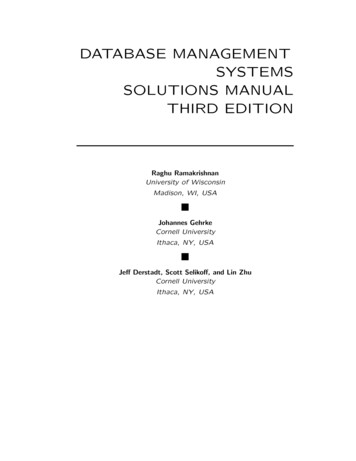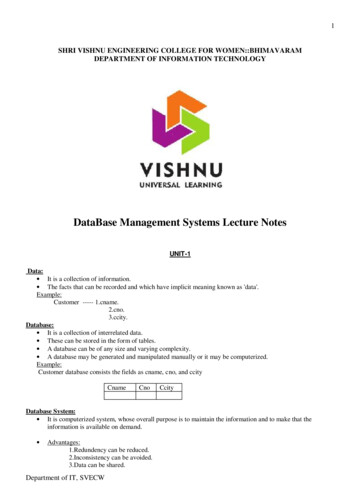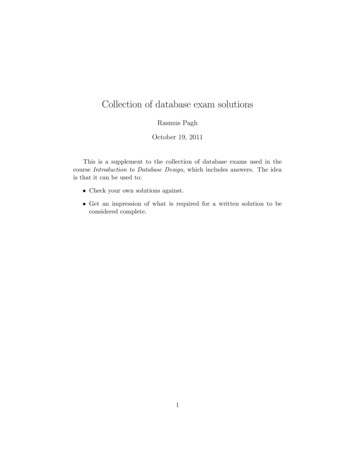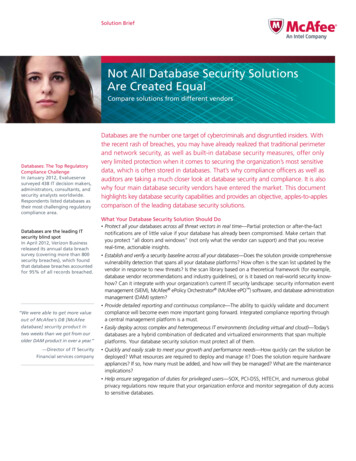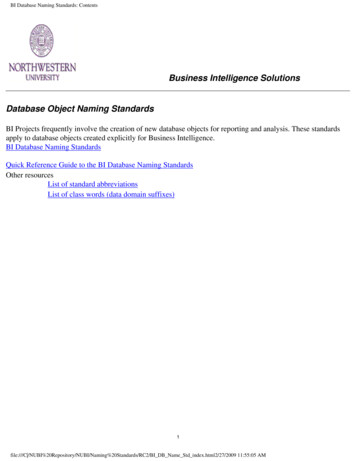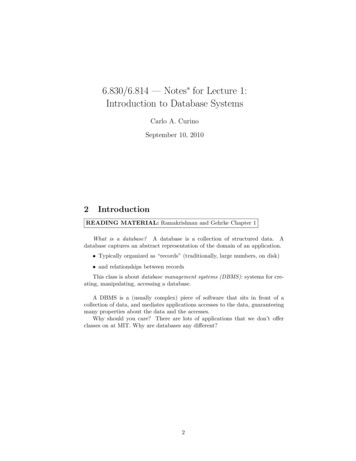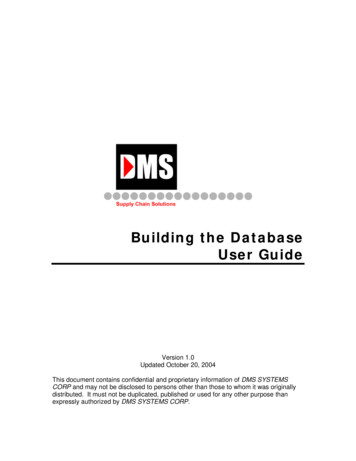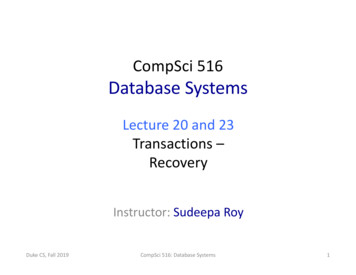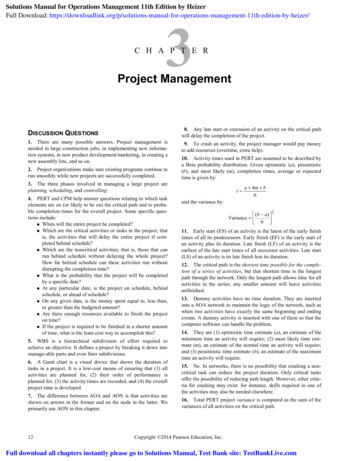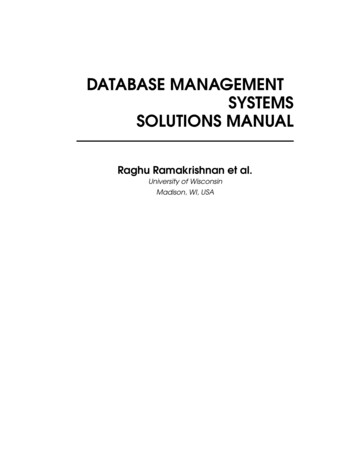
Transcription
DATABASE MANAGEMENTSYSTEMSSOLUTIONS MANUALRaghu Ramakrishnan et al.University of WisconsinMadison, WI, USA
2THE ENTITY-RELATIONSHIP MODELExercise 2.1 Explain the following terms briefly: attribute, domain, entity, relationship, entity set, relationship set, one-to-many relationship, many-to-many relationship,participation constraint, overlap constraint, covering constraint, weak entity set, aggregation, and role indicator.Answer 2.1 No answer provided yet.Exercise 2.2 A university database contains information about professors (identifiedby social security number, or SSN) and courses (identified by courseid). Professorsteach courses; each of the following situations concerns the Teaches relationship set.For each situation, draw an ER diagram that describes it (assuming that no furtherconstraints hold).1. Professors can teach the same course in several semesters, and each offering mustbe recorded.2. Professors can teach the same course in several semesters, and only the mostrecent such offering needs to be recorded. (Assume this condition applies in allsubsequent questions.)3. Every professor must teach some course.4. Every professor teaches exactly one course (no more, no less).5. Every professor teaches exactly one course (no more, no less), and every coursemust be taught by some professor.6. Now suppose that certain courses can be taught by a team of professors jointly,but it is possible that no one professor in a team can teach the course. Model thissituation, introducing additional entity sets and relationship sets if necessary.Answer 2.2 Answer omitted.5
6Chapter 2Exercise 2.3 Consider the following information about a university database:Professors have an SSN, a name, an age, a rank, and a research specialty.Projects have a project number, a sponsor name (e.g., NSF), a starting date, anending date, and a budget.Graduate students have an SSN, a name, an age, and a degree program (e.g., M.S.or Ph.D.).Each project is managed by one professor (known as the project’s principal investigator).Each project is worked on by one or more professors (known as the project’sco-investigators).Professors can manage and/or work on multiple projects.Each project is worked on by one or more graduate students (known as theproject’s research assistants).When graduate students work on a project, a professor must supervise their workon the project. Graduate students can work on multiple projects, in which casethey will have a (potentially different) supervisor for each one.Departments have a department number, a department name, and a main office.Departments have a professor (known as the chairman) who runs the department.Professors work in one or more departments, and for each department that theywork in, a time percentage is associated with their job.Graduate students have one major department in which they are working on theirdegree.Each graduate student has another, more senior graduate student (known as astudent advisor) who advises him or her on what courses to take.Design and draw an ER diagram that captures the information about the university.Use only the basic ER model here, that is, entities, relationships, and attributes. Besure to indicate any key and participation constraints.Answer 2.3 The ER diagram is shown in Figure 2.1.Exercise 2.4 A company database needs to store information about employees (identified by ssn, with salary and phone as attributes); departments (identified by dno,with dname and budget as attributes); and children of employees (with name and ageas attributes). Employees work in departments; each department is managed by an
specialitypidThe Entity-Relationship Modelagestart datework inssnranksponsorend dateFigure 2.1budgetManagesProfessorER Diagram for Exercise 2.3Work deptprojectSupervisesRunsssnWork projpc essndnameagedeg prog7
8Chapter 2employee; a child must be identified uniquely by name when the parent (who is anemployee; assume that only one parent works for the company) is known. We are notinterested in information about a child once the parent leaves the company.Draw an ER diagram that captures this information.Answer 2.4 Answer omitted.Exercise 2.5 Notown Records has decided to store information about musicians whoperform on its albums (as well as other company data) in a database. The companyhas wisely chosen to hire you as a database designer (at your usual consulting fee of 2,500/day).Each musician that records at Notown has an SSN, a name, an address, anda phone number. Poorly paid musicians often share the same address, and noaddress has more than one phone.Each instrument that is used in songs recorded at Notown has a name (e.g., guitar,synthesizer, flute) and a musical key (e.g., C, B-flat, E-flat).Each album that is recorded on the Notown label has a title, a copyright date, aformat (e.g., CD or MC), and an album identifier.Each song recorded at Notown has a title and an author.Each musician may play several instruments, and a given instrument may beplayed by several musicians.Each album has a number of songs on it, but no song may appear on more thanone album.Each song is performed by one or more musicians, and a musician may perform anumber of songs.Each album has exactly one musician who acts as its producer. A musician mayproduce several albums, of course.Design a conceptual schema for Notown and draw an ER diagram for your schema. Thefollowing information describes the situation that the Notown database must model.Be sure to indicate all key and cardinality constraints and any assumptions that youmake. Identify any constraints that you are unable to capture in the ER diagram andbriefly explain why you could not express them.Answer 2.5 The ER diagram is shown in Figure 2.2.
ssninstrIdnameFigure 2.2ER Diagram for Exercise mIdentifierTelephonePlaceHomephone noaddresssuthorspeedtitleThe Entity-Relationship Model9
10Chapter 2Exercise 2.6 Computer Sciences Department frequent fliers have been complainingto Dane County Airport officials about the poor organization at the airport. As aresult, the officials have decided that all information related to the airport should beorganized using a DBMS, and you’ve been hired to design the database. Your first taskis to organize the information about all the airplanes that are stationed and maintainedat the airport. The relevant information is as follows:Every airplane has a registration number, and each airplane is of a specific model.The airport accommodates a number of airplane models, and each model is identified by a model number (e.g., DC-10) and has a capacity and a weight.A number of technicians work at the airport. You need to store the name, SSN,address, phone number, and salary of each technician.Each technician is an expert on one or more plane model(s), and his or her expertise may overlap with that of other technicians. This information about techniciansmust also be recorded.Traffic controllers must have an annual medical examination. For each trafficcontroller, you must store the date of the most recent exam.All airport employees (including technicians) belong to a union. You must storethe union membership number of each employee. You can assume that eachemployee is uniquely identified by the social security number.The airport has a number of tests that are used periodically to ensure that airplanes are still airworthy. Each test has a Federal Aviation Administration (FAA)test number, a name, and a maximum possible score.The FAA requires the airport to keep track of each time that a given airplaneis tested by a given technician using a given test. For each testing event, theinformation needed is the date, the number of hours the technician spent doingthe test, and the score that the airplane received on the test.1. Draw an ER diagram for the airport database. Be sure to indicate the variousattributes of each entity and relationship set; also specify the key and participationconstraints for each relationship set. Specify any necessary overlap and coveringconstraints as well (in English).2. The FAA passes a regulation that tests on a plane must be conducted by a technician who is an expert on that model. How would you express this constraint inthe ER diagram? If you cannot express it, explain briefly.Answer 2.6 Answer omitted.
The Entity-Relationship Model11Exercise 2.7 The Prescriptions-R-X chain of pharmacies has offered to give you afree lifetime supply of medicines if you design its database. Given the rising cost ofhealth care, you agree. Here’s the information that you gather:Patients are identified by an SSN, and their names, addresses, and ages must berecorded.Doctors are identified by an SSN. For each doctor, the name, specialty, and yearsof experience must be recorded.Each pharmaceutical company is identified by name and has a phone number.For each drug, the trade name and formula must be recorded. Each drug issold by a given pharmaceutical company, and the trade name identifies a druguniquely from among the products of that company. If a pharmaceutical companyis deleted, you need not keep track of its products any longer.Each pharmacy has a name, address, and phone number.Every patient has a primary physician. Every doctor has at least one patient.Each pharmacy sells several drugs and has a price for each. A drug could be soldat several pharmacies, and the price could vary from one pharmacy to another.Doctors prescribe drugs for patients. A doctor could prescribe one or more drugsfor several patients, and a patient could obtain prescriptions from several doctors.Each prescription has a date and a quantity associated with it. You can assumethat if a doctor prescribes the same drug for the same patient more than once,only the last such prescription needs to be stored.Pharmaceutical companies have long-term contracts with pharmacies. A pharmaceutical company can contract with several pharmacies, and a pharmacy cancontract with several pharmaceutical companies. For each contract, you have tostore a start date, an end date, and the text of the contract.Pharmacies appoint a supervisor for each contract. There must always be a supervisor for each contract, but the contract supervisor can change over the lifetimeof the contract.1. Draw an ER diagram that captures the above information. Identify any constraints that are not captured by the ER diagram.2. How would your design change if each drug must be sold at a fixed price by allpharmacies?3. How would your design change if the design requirements change as follows: If adoctor prescribes the same drug for the same patient more than once, several suchprescriptions may have to be stored.
12Chapter 2ageaddressnamessnspecialityphy ssnnamePri hone numquentitytrade namePharmacySellDrugformulastart dateend datepriceMakeContractPharm cotextsupervisornameFigure 2.3phone numER Diagram for Exercise 2.8exp years
The Entity-Relationship ModelAnswer 2.7131. The ER diagram is shown in Figure 2.3.2. If the drug is to be sold at a fixed price we can add the price attribute to the Drugentity set and eliminate the Sell relationship set.3. The date information can no longer be modeled as an attribute of Prescription.We have to create a new entity set called Prescription date and make Prescriptiona 4-way relationship set that involves this additional entity set.Exercise 2.8 Although you always wanted to be an artist, you ended up being anexpert on databases because you love to cook data and you somehow confused ‘database’ with ‘data baste.’ Your old love is still there, however, so you set up a databasecompany, ArtBase, that builds a product for art galleries. The core of this productis a database with a schema that captures all the information that galleries need tomaintain. Galleries keep information about artists, their names (which are unique),birthplaces, age, and style of art. For each piece of artwork, the artist, the year it wasmade, its unique title, its type of art (e.g., painting, lithograph, sculpture, photograph),and its price must be stored. Pieces of artwork are also classified into groups of variouskinds, for example, portraits, still lifes, works by Picasso, or works of the 19th century;a given piece may belong to more than one group. Each group is identified by a name(like those above) that describes the group. Finally, galleries keep information aboutcustomers. For each customer, galleries keep their unique name, address, total amountof dollars they have spent in the gallery (very important!), and the artists and groupsof art that each customer tends to like.Draw the ER diagram for the database.Answer 2.8 Answer omitted.
3THE RELATIONAL MODELExercise 3.1 Define the following terms: relation schema, relational database schema,domain, relation instance, relation cardinality, and relation degree.Answer 3.1 A relation schema can be thought of as the basic information describinga table or relation. This includes a set of column names, the data types associatedwith each column, and the name associated with the entire table. For example, arelation schema for the relation called Students could be expressed using the followingrepresentation:Students(sid: string, name: string, login: string,age: integer, gpa: real)There are five fields or columns, with names and types as shown above.A relational database schema is a collection of relation schemas, describing one or morerelations.Domain is synonymous with data type. Attributes can be thought of as columns in atable. Therefore, an attribute domain refers to the data type associated with a column.A relation instance is a set of tuples (also known as rows or records) that each conformto the schema of the relation.The relation cardinality is the number of tuples in the relation.The relation degree is the number of
Exercise 2.7 The Prescriptions-R-X chain of pharmacies has o ered to give you a free lifetime supply of medicines if you design its database. Given the rising cost of health care, you agree. Here’s the information that you gather: Patients are identi ed by an SSN, and their names, addresses, and ages must be recorded. Doctors are identi ed by an SSN. For each doctor, the name, specialty, and years
